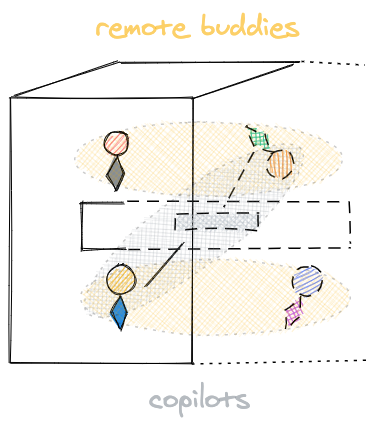Buddy System, Copilots, and Async for Hybrid Remote Work

You may have heard of the working agreement that “when one is remote, all should be remote”. This agreement applies to remote hybrid teams where some team members may be in the office and some team members are either working from home or other locations. Such working agreements encourage all meetings to be run as remote meetings and avoid gatherings in conference rooms. These agreements provide more balanced communication between team members in and out of office.
However, some team members and managers may resist such working agreements. You may hear comments like: “Why sit at your desk and meet when you have conference rooms? Why can’t I just talk to people near me? This just seems more natural.”
It is exactly how our human communications and language skills developed.
This makes hybrid remote teams seem challenging as we shift from full distributed teams to hybrid remote teams in response to the pandemic. So rather than “fight” our natural tendencies for communication, perhaps we can rely on other natural tendencies to support communication in our hybrid remote teams. It will take more than resilience.
Do you have your work buddy?
Before I learned about Gallup’s research on employee engagement and the importance of having a friend at work, I discovered a remote work buddy becomes vital to more effective remote team collaboration. This becomes even more important for remote hybrid teams.
In this remote “buddy system”, you have one person in the office acting as the buddy for the remote person. Usually, this model supports collaborative meetings where everyone cannot be in the office (or same conference room) for one reason or another.
The in-room buddy becomes eyes, ears, voice, and hands for the remote buddy during collaborative meetings. They stay connected via some form of backchannel and make sure in-room and out-of-room team members remain connected in meetings.
Some conscientious in-office buddies even relay hallway conversations and water cooler chats.

Do you lead with a copilot?
When groups of people gather in different locations, a new kind of remote buddy evolves called the remote copilot. Each location has a copilot and shares responsibility for the local group of people making up the distributed team.
In meetings, copilots co-facilitate and serve the needs of their local group by signaling questions to the rest of the people in the meeting. Or, a copilot may slow things down when one group misses a key point in the meeting.
Outside of meetings, the copilots serve the team by listening and coordinating support of the team. The copilots will sync up often (sometimes in their own daily standup meeting) to check in with each other and what they observe with their parts of the team. They can relay when a “local office event” may impact the part of the team in their location and ask for support from other parts of the team. The local copilot may just request empathy and understanding.
Variations on this copilot approach may include:
- A pilot-copilot arrangement where one leads and the other supports. You see this in meetings with a facilitator and technical producer or a senior coach and coach role outside of meetings.
- True copilots are co-leaders that plan and lead meetings together as well as equally share the service to the team.
- Larger teams combine the variations above and could even produce some specializations in the copilots based on the different types of support needed by the overall team or a specific location based on technology, language, or culture differences.
The key to the copilots depends on serving all the needs of the distributed team and to make sure all can equally contribute.
Also, copilots and buddies represent different types of servant leadership that can be part of other support roles or rotate among team members. What can individual team members do to support each other in hybrid remote work?
Do you balance synchronous and asynchronous work?
Even highly collaborative distributed teams will have times of solo focus and hours of overlap. The “hours of overlap” define optimal collaboration time for all team members. This time not only supports meetings, but also ad hoc collaboration. These ad hoc collaborations provide opportunities for team members to seek out diverse opinions from fellow team members on the quality and direction of the work. They may even co-create parts of the work by sharing domain knowledge and transferring skills in the process.
Outside the hours of overlap, team members can focus on solo contributions while still “leaving a trail” for team members (as my colleague Michal Parkola says). Other team members can follow these information trails as needed. Sometimes they may follow upon request to review the work. Other times, they may follow the information paths provided by team members to solve related problems in the work. Regardless, these information trails provide opportunities for diverse solutions and allow all team members to contribute.
What about the tech?
Often, I find people who struggle with remote hybrid teams seek a technology solution. However, the technology does not support our natural tendencies to communicate and connect, the tech solution will be a novelty for some. For other (or most) people, the technology irritates those who seek a natural way to communicate and collaborate on remote hybrid teams.
To learn more about the steps for the buddy system or copilots, see my book or my workshops created with my colleague Johanna Rothman.
If you are interested in how to balance asynchronous and synchronous work, join me and Michal Parkola for an upcoming workshop.
To learn the key to make these approaches work, read the next blog post on inclusivity.
